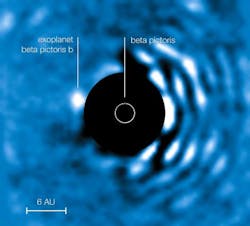Exoplanet hunters develop apodizing phase-plate coronagraph

Tucson, AZ--Using an apodizing phase-plate (APP) coronagraph developed at the University of Arizona's (UA's) Steward Observatory, astronomers have obtained images of a planet in a much closer orbit around its parent star than any other extrasolar planet previously found.
Installed on the European Southern Observatory's Very Large Telescope (VLT; Paranal Mountain, Chile), the coronograph allowed the scientists to confirm the existence and orbital movement of Beta Pictoris b, a planet about seven to ten times the mass of Jupiter, around its parent star Beta Pictoris, 63 light years away (see figure). The APP has an intricate phase pattern etched into it, which has the effect of blocking out the central starlight in a very defined way, allowing exoplanets to show up in the image.
"Until now, we only were able to look at the outer planets in a solar system, in the range of Neptune's orbit and beyond. Now we can see planets on orbits much closer to their parent star," says Phil Hinz, director of the UA's Center for Astronomical Adaptive Optics at Steward Observatory.
Where the planets are
Neptune's mean distance from the sun is about 2.8 billion miles, or 30 astronomical units (AUs). One AU is the mean distance between the sun and the Earth. The newly imaged planet, Beta Pictoris b, orbits its star at about seven AUs, a distance where things get especially interesting, according to Hinz, "because that's where we believe the bulk of the planetary mass to be in most solar systems—between five and 10 AUs."
According to Hinz, the growing number of extrasolar planets discovered to date by directly observing them--mostly supermassive gas giants in very large orbits--represents a biased sample because their size and distance to their parent star makes them easier to detect. "The technique we developed allows us to search for lower-mass gas giants about the size of Jupiter, which are more representative of what is out there," he says. "For the first time, we can search around bright nearby stars such as Alpha Centauri to see if they have gas giants."
No aiming needed
Johanan Codona, a senior research scientist at the UA's Steward Observatory who developed the theory behind the technique, which he calls phase-apodization coronagraphy, used his own unconventional mathematical approach to model the phase plate. To block out glare from a star, conventional coronagraphs have to be precisely lined up and are highly susceptible to disturbance. The APP, on the other hand, requires no aiming and works equally well on any stars or locations in the image.
The discovery is a result of an international collaboration among the Steward Observatory, the Swiss Federal Institute of Technology Zurich, the European Southern Observatory, Leiden University in the Netherlands, and Germany's Max-Planck-Institute for Astronomy.
REFERENCE:
1. Sascha P. Quanz et al., Astrophysical Journal Letters, Vol. 722, No. 1, 10 Oct. 2010.

John Wallace | Senior Technical Editor (1998-2022)
John Wallace was with Laser Focus World for nearly 25 years, retiring in late June 2022. He obtained a bachelor's degree in mechanical engineering and physics at Rutgers University and a master's in optical engineering at the University of Rochester. Before becoming an editor, John worked as an engineer at RCA, Exxon, Eastman Kodak, and GCA Corporation.